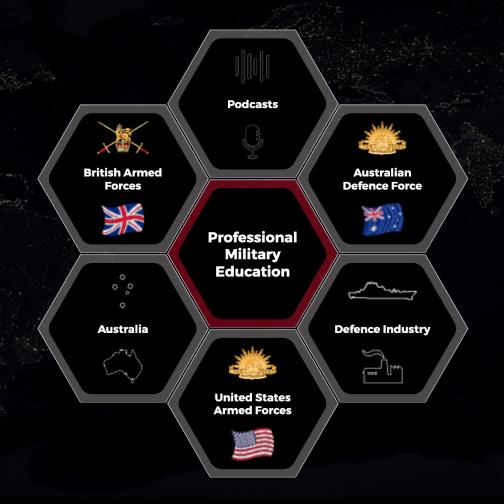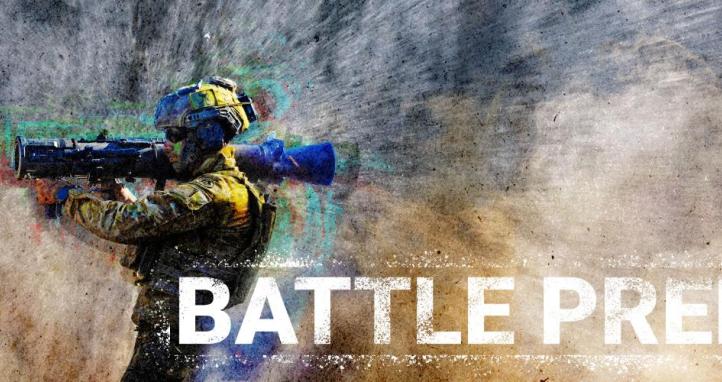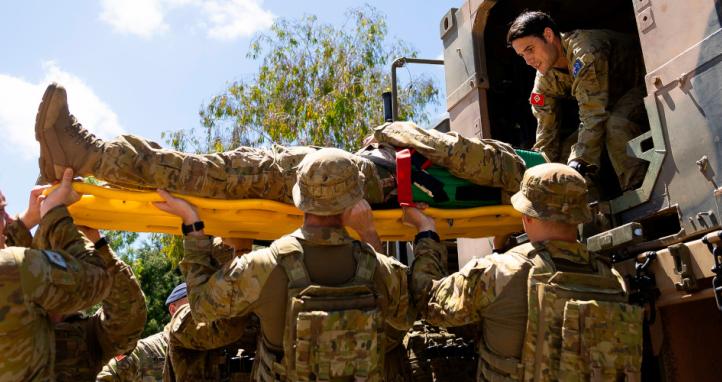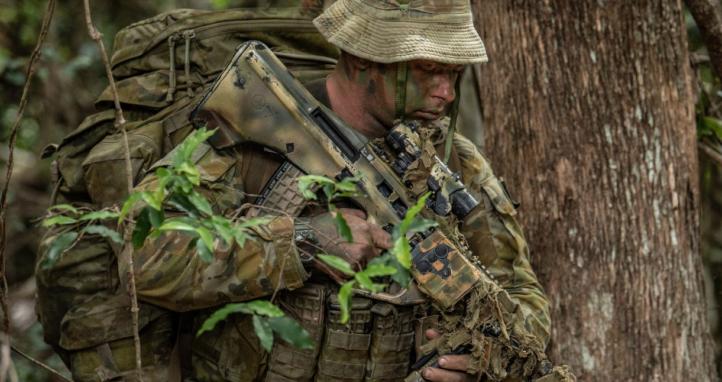This article was a submission in the Cove Competition 2024.
There exists a need to comprehensively consider the risk that planned acquisitions of new technologies through Defence Strategic Review (DSR) may be outdated by the time of procurement. Australia’s acceleration in warfare technology must continue to evolve through innovative adaptive solutions within its ranks. Australia must lead the way to convincingly adapt to the ever changing nature of war.
Possessing greater weapon systems and mobility platforms such as those detailed in the DSR continue to be fundamental. It guarantees that the Australian Defence Force (ADF) has a solid foundation in which to credibly operate as a force and remain internationally relevant. However, it is crucial that our force achieves a balance between possessing the best in military capability, and ensuring we lead the way in adapting to change in accelerated warfare.
Accelerating weapon and platform technology is not the only improvement that needs to be considered. Tactical military strategy needs to continue to evolve in order to ensure our force remains unpredictable. Not unlike the employment of German Forces in World War Two, which saw the employment of previously unseen technological advancements coupled with a change in military strategy e.g. ‘Blitzkrieg’, the ADF must practice new ways to create psychological shock, disorganisation of enemy forces, and ultimately achieve superiority in theatres of war.
Acceleration in tactics and technology does not have to be sexy
Different types of warfare will exhibit different examples of technological advancements. These examples are almost always preceded by a need to change and adapt. More often than not, these changes have enabled success for the forces that are employing the change in strategy.
Guerrilla warfare has existed since the time of Sun Tzu and has evolved over the years to be employed by forces such as the North Vietnamese Army in the Vietnam War, the Mujahedeen and Taliban in Afghanistan, and even more recently by Hamas in the Israeli-Palestinian conflict.
Low cost weapons such as booby-traps, improvised explosive devices, and drones can all be placed on the spectrum of low level technological advancements that have changed the way large scale conflict is fought.
As an example, utilising a low-cost, off-the-shelf UAV, a guerrilla force was able to demonstrate how a multimillion dollar attack helicopter can be rendered useless by a drone worth less than $1000. This tactic poses minimal risk of a force sustaining casualties and also provides a low cost lethal capability able to be employed multiple times.
The need to own both ends of the technological spectrum
While low cost improvised technology needs to continue to evolve in order to avoid our force becoming overly reliant on advanced weapon systems, there continues to be a need for the ADF to own the high end of the technology spectrum. Advancements in artificial intelligence (AI) will deliver the ability to not only target enemy weapon systems, but also to target enemy soldiers’ will to fight.
While force elements can sometimes fixate on the weapon systems and their ability to cause physical damage, it must be noted that the human element of warfare still remains the determining factor between failure and success.
“Wars end when the human will to fight runs out”
– extract from the Australian Army contribution to the national defence strategy 2024 (pg. 23)
Observing Dahiya Doctrine (Israeli military strategy) as a ‘base level’ idea, AI could be used to target large scale enemy infrastructure of an enemy state. The stress placed on the population would result in them turning on the military element, forcing them to consider their probability of long term success.
It must always be a consideration that Australia remains a signatory to a number of conventions that protect the rights of the civilian population and non-combatants. Any attrition warfare achieved through the employment of artificial intelligence that may cause damage to civilian infrastructure (be it physical or virtual) must always be reasonable and justifiable.
Multiply the Multi-Domain Battle Space
With the increase in potential adversaries both regional and worldwide, Australia has a need to develop its ability to deter hostile engagement. Physically this can be achieved through the ability of employing new long range weapon systems and platforms, as well as integrating command and control in a Joint environment. Internationally, we have the responsibility to be interoperable with allied forces looking to achieve the same deterrence.
This will require the ADF to employ capabilities across multiple areas including Land, Air, Sea, Space, Cyberspace, and other Virtual domains. In order to deter any thought of hostile armed engagement, Australia must have the technological capability to render any potential threat moot.
It is understood that traditional warfare has been fought on land, sea, and in the air. The new multi-domain style of warfare will require almost hourly changes to technological tactics, able if necessary to be supported by physical Battlespace Operating Systems. This will require significant investment in both technological capability as well as the operators that employ the systems. There will be a requirement to continue to develop the capability of the systems in order for them to remain relevant in the future warfare space.
Conclusion
The changing character of warfare will require significant investment in physical weaponry, platform delivery, tactical military strategy, and technological advancement. The Australian Defence Force has already committed billions of dollars in upgrading their physical capability to engage weapon systems through the Defence Strategic Review. Parallel to this, significant investment in accelerating our role in developing other technology used in future warfare needs consideration.
Low-cost adaptable drones (for Land, Sea, and Air), employable AI in virtual domains, as well as investment in operators that are capable of continuous development in the future operation space are a minimum standard requirement in order for the Australian Defence Force to remain relevant in future warfare.
If the Australian Defence Force shows the willingness to invest in continuous improvement over the new multi-domain battlespace, deterrence may be enough to deny any credible threats to Australia, maintain security stability for our regional partners and continue our commitment to the global rules-based order.










Such an ability is necessarily the display to the potential future opponent the range of capabilities available to the ADF should aggressive action be contemplated.
The effect of such a 'deterrence' is in fact to encourage an arms race where countermeasures are acquired to defeat the proposed deterrent, restoring assumed superiority and prospects of success in achieving ADF's defeat.
"Deterrence" is therefore not the solution, but the problem.
In regards to acceleration of warfare, this is not well explained.
There are several concepts that deal with the exploitation of time in warfare: speed of information (intelligence gathering), speed of decision, speed of troops' deployment responding to the command decision, and speed of combat, the enabling of the "...end when the human will to fight runs out”.
In the original ADF "Accelerated Warfare" concept by LTGEN Burr, the "Army in Motion" urged creative responses from the Army to disruptive technologies, but did not propose solutions to the above spectrum of accelerations in warfare. There are still no solutions because the Army's 'creative juices' are not flowing, and haven't done so since 2000 Maritime Strategy.
And here, the writer ought to have considered that the character of warfare is not constantly changing for the ADF. It had been, and will remain a maritime character of warfare, that is, involving warfare requiring special operations in water, formerly coastal warfare, and later amphibious, now littoral.
The change in words has not change the fact that what the Australian Army faces is the challenge of the most complex warfare environment for armies, water. The solution for accelerating warfare in this complex environment has not even commenced to be approached by the Army. Foreshadowed procurement of antiquated technology (ramp-accessed beach landing craft) suggests there is no one thinking creatively and LTGEN Burr's message was wasted on the Army.
This is the long and the short of it. The Army lacks capacity for innovation which is one of its principal value. This was not addressed by the LAND400 Phase 3, the principal means of achieving accelerated warfare https://www.aspistrategist.org.au/accelerated-warfare-requires-creative-responses-to-new-threats/